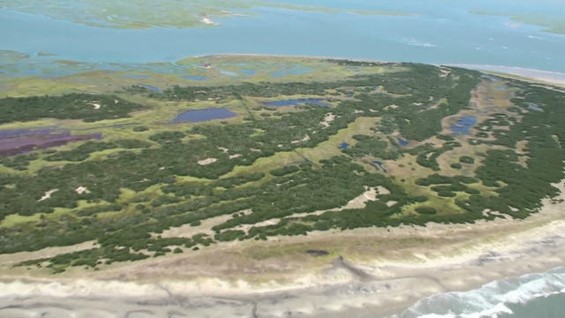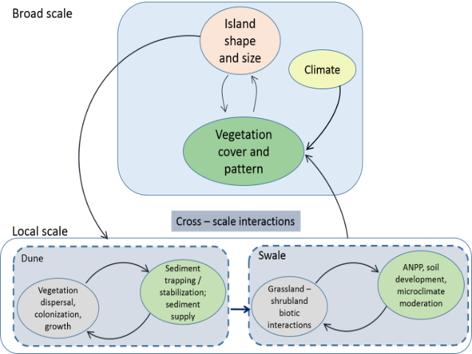Current Research

Regime shifts between grassland and shrubland states may be driven by plants physiological responses to multiple environmental drivers, which are spatially and temporally variable. Grassland has considerably more variable temperature, moisture and salinity conditions, which likely prevent successful establishment of shrub seedlings, thereby maintaining a grassland state. Once grassland is converted to shrub thicket, there are significant alterations in microclimate that induce feedbacks to positively favor the maintenance of shrub thicket. The dominant woody species on Virginia barrier islands, Morella cerifera (formerly Myrica cerifera), exhibits robust physiological and functional traits that may enhance growth with alterations in microclimate. Warmer winter temperatures associated with thickets and the evergreen leaf habit provide the potential to fix carbon throughout the year, enhancing annual net primary productivity (ANPP) and total cover. Morella cerifera has a moderately high temperature optimum for photosynthesis (30 °C) indicating a preference for warmer temperatures. Thus, warmer temperatures result in higher growth potential and ET. Through control on ET, shrubs appear to modify depth to the water table, creating more suitable habitat in island swales by reducing anoxic conditions in the soil. Enhanced N may increase grass/forb density in dry grassland to facilitate survival of shrub seedlings. Recent changes in climate may provide further positive feedbacks to maintain shrub communities. Frequency and intensity of summer droughts are expected to increase in response to predicted shifts in global climate patterns. These effects will be exacerbated by microtopography. In the short term, declines in precipitation will contribute to lowering the water table leading to more favorable shrub habitat. Shrubs with higher ET and expected tighter stomatal regulation can utilize infrequent pulses of precipitation better than grassland species. Currently, distribution of M. cerifera is limited to swale environments indicating that freshwater and moisture conditions are critical factors affecting shrub expansion.
Local vegetation type and cover can strongly influence barrier island response to disturbance In areas where grassland converts to shrubland, extensive woody vegetation augments resilience by allowing the system to absorb disturbance while remaining within the same state. However, over longer time frames (decades), extensive woody cover blocks sediment transfer and causes extensive shoreline erosion. Conversely, grassy swales with little to no woody vegetation promote overwash of sediments and, ultimately, island migration. This has particular relevance for coastal management in short-term stabilization (e.g. dune building grasses, woody vegetation) and long-term barrier island persistence.

Published in Zinnert et al. 2017. BioScience
Through synthesis of the last 30 years of barrier island research, we developed a conceptual framework that identifies multi scale-dependent drivers and cross-scale interactions that we hypothesize lead to rapid change in response to climate change, especially sea-level rise. In our conceptual framework, local scale processes can be separated as occurring within two distinct geomorphological units: dunes and swales, which interact to affect barrier island shape and size. Vegetation growth influences transfer processes of sediment supply by trapping and stabilizing sand in different dune morphologies. Trapping of sediment creates new substrate for further colonization by plants or it can alter elevation resulting in ecological-topographic feedbacks at the local scale. As islands develop, these feedbacks between vegetation and sediment results in cross-scale interactions in which vegetation cover type and patterns emerge at the broad scale leading to contrasting ecosystem function and resiliency among islands. Interactions between the physical landscape and vegetation results in cross-island stability domains (disturbance-reinforcing and disturbance-resisting) that differ in topographic structure and vegetative composition. Linking local and broad scale processes (i.e. drivers and response variables) and key cross-scale interactions will transform our understanding of system response to climate change by focusing on the interactions of mechanisms operating at different spatial scales. This will allow for accurate prediction and modeling of local scale processes to play a self-organizing resilient function in the face of climate and the longer term maintenance of the coastal profile at larger scales.
There are significant variations in sea-level rise and shoreline change along the Atlantic coast, with the VCR located within a northeast hotspot where rising sea-level is 3-4 times the global average (Sallenger et al. 2012). We have been assessing changes in ecosystem state (marsh, bare sand, grassland, and shrubland) from multi-decdal remote sensing imagery on the Virginia barrier islands. Between 1984-2016, we found that total island area (upland and back-barrier marsh) was reduced by 18%, representing over 1600 ha loss of upland communities and 1300 ha of back-barrier marsh converting to island upland. These rates of change are temporally and spatially variable. Loss of island area ranges from 12% - 62%, depending on landscape position. Despite this reduction in island area and transitions between ecosystem states, woody vegetation continues to increase across the landscape. Three patterns of transitions between grassland and shrubland occur, with patterns potentially linked to island elevation and topographic roughness. We propose that these vegetation dynamics influence overall resistance or resilience to sea-level rise and storms, and are continuing our analysis of historical and contemporary imagery, patterns, and drivers of change.
The dramatic shift in ecosystem state across the VCR represents uncertainty in the carbon stocks of terrestrial upland soils. As woody vegetation rapidly increases across the landscape, aboveground net primary productivity (ANPP) is significantly increased. The physical environment of coastal ecosystems is highly dynamic compared to inland terrestrial ecosystems. Coastal soils accrete and erode over decades resulting in rapid changes in both vegetation and microbial communities. Because geological processes work at shorter time scales in coastal ecosystems, soil turnover is rapid and new mineral soils are exposed more frequently. High rates of shrub ANPP coupled with variability in soil turnover from disturbance create uncertainty in estimating C pools from coastal soils. Sandy soils are not efficient in retaining organic matter, potentially resulting in C export from coastal soils to adjacent systems. Terrestrial plant communities endemic to coastal ecosystems are strongly influenced by dynamic coastal processes, exhibit unique biogeochemical cycling and may serve as sentinels of climate change - but remarkably little is known about C cycling in these systems. We are assessing C storage and potential export in barrier islands.